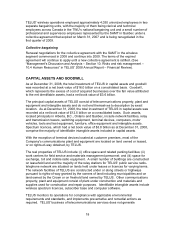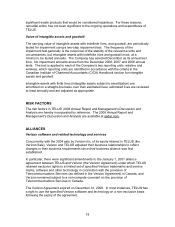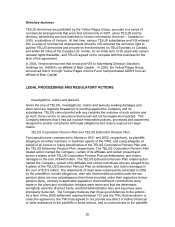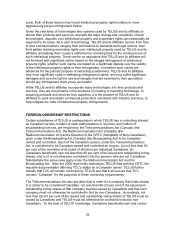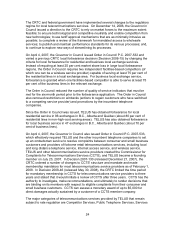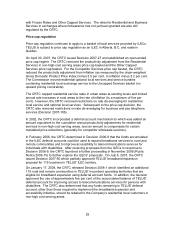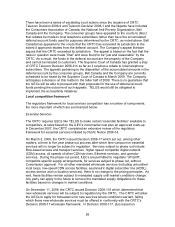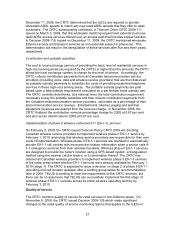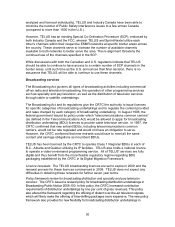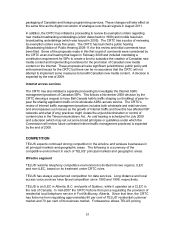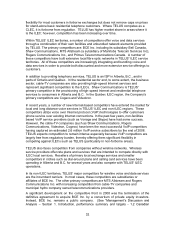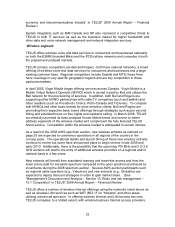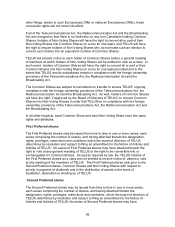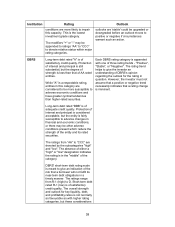Telus 2008 Annual Report Download - page 28
Download and view the complete annual report
Please find page 28 of the 2008 Telus annual report below. You can navigate through the pages in the report by either clicking on the pages listed below, or by using the keyword search tool below to find specific information within the annual report.non-forborne areas. The CRTC eliminated the retail rate adjustment plan and reduced
the number of quality of service indicators being monitored from 17 to three.
The CRTC also monitors quality of service for competitor services and enforces a rate
adjustment plan and associated rebates for ILECs that do not meet approved quality of
service standards for these services.
Regulation of wireless services
The use of radio spectrum is subject to regulation and licensing by Industry Canada
pursuant to the Radiocommunication Act, which is administered by Industry Canada. All
of TELUS’ wireless communications services depend on the use of radio frequencies.
While economic regulation of wireless services falls under CRTC jurisdiction, wireless
services have, generally, been subject to regulatory forbearance.
The Minister of Industry has the authority to suspend or revoke radio spectrum licences
if the licence holder has contravened the Radiocommunication Act, regulations or terms
and conditions of its licence and after giving the holder of the licence a reasonable
opportunity to make representations. Licence revocation is rare; licences are usually
renewed upon expiration (see “Management’s Discussion and Analysis – Section 10.
Risks and risk management – 10.3 Regulatory” in TELUS’ 2008 Annual Report –
Financial Review).
Wireless Number Portability. Wireless number portability (WNP) enables consumers to
retain their telephone number when switching between service providers or between
wireline and wireless service. In Decision 2005-72, the CRTC directed Bell Mobility,
Rogers Wireless Inc. and the wireless division of TELUS to fully implement WNP by
September 2007. TELUS has successfully completed this implementation. Canada was
the second country in the world after the United States to offer complete number
portability (wireless-to-wireless, wireless-to-wireline and wireline-to-wireless). TELUS has
experienced modestly higher churn rates since the introduction of WNP. The initial post-
WNP phase of pent-up demand to switch has subsided, but churn rates may be
permanently higher in the future.
Radiocommunications spectrum licences
TELUS holds radiocommunication spectrum licences and authorizations for a variety of
wireless services and applications, both mobile and fixed. TELUS holds significant 1.9
GHz PCS spectrum throughout Canada, is the leading holder of 800 MHz SMR/ESMR
spectrum in all of the major Canadian markets, and holds 25 MHz of cellular 800 MHz
spectrum in Alberta, B.C. and eastern Québec. In addition, TELUS holds various radio
spectrum licences for fixed services in the 24/38 GHz, 2.3/3.5 GHz band throughout
Canada, paging services, analogue two-way radio services, and legacy mobile-
telephone and other miscellaneous wireless services.
Licence terms and renewals. Currently, spectrum licences in Canada for PCS and
cellular spectrum will expire in 2011 and 2013 (see “Management’s Discussion and
Analysis – Section 10. Risks and risk management – 10.3 Regulatory” in TELUS’ 2008
Annual Report – Financial Review). The spectrum licences for the auctioned 24/38
GHz, 2.3/3.5 GHz and PCS spectrum have a ten-year term from the date of issuance.
Most other radiocommunications spectrum licences are renewed annually (see
28


